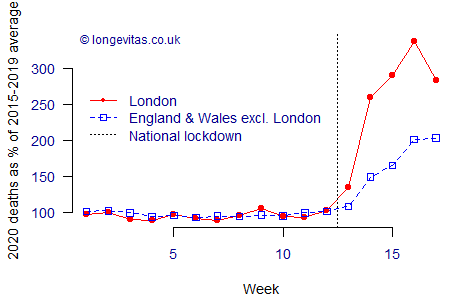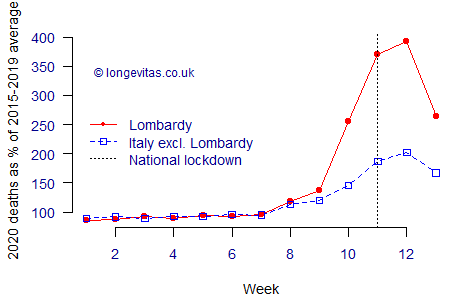The renewed importance of place
In my previous blog I showed how suddenly the excess deaths rose in Scotland and England & Wales due to the ongoing COVID-19 pandemic. I plotted the excess weekly mortality in two separate graphs because the two countries had such a similar experience that a single figure would have looked muddled. One might be tempted to conclude that all parts of the UK are equally affected, but this is very far from the case, as Figure 1 shows.
Figure 1. Deaths in Weeks 1–16 in England & Wales in 2020 as percentage of average in 2015-2019. Source: own calculations using data from ONS (2020).

The increase in mortality Figure 1 could justifiably be described as staggering: in the week to 17th April deaths in London were running at over three times the normal rate expected for the time of year. There are further differentials amongst the regions of England & Wales, but none sticks out as much as the excess mortality in London. London's unenviable position within England & Wales is not unusual either, as shown in Figure 2 for the Lombardy region in Italy.
Figure 2. Deaths in Weeks 1–13 in Italy in 2020 as percentage of average in 2015-2019. Source: own calculations using data from Istat (2020). Note that the first "week" is actually a ten-day period to 11th January.

With an infectious disease, specifics of local behaviour and circumstances can make a big difference. For example, travel on London's underground trains during rush hour is the very opposite of the social distancing that many governments have ordered. When the history of the COVID-19 pandemic is written, we will doubtless hear more about the specifics of places such as London and Lombardy. In the meantime, readers of this blog should continue to keep their distance and wash their hands.
References:
Istat (2020), Total deaths per age class, week of demographic event and municipality of residence at the time of death. Reference period: 01/01-04/04, Years 2015-2020; accessed 3rd May 2020.
ONS (2020), Deaths registered weekly in England & Wales. Provisional counts for week to 24th April 2020; accessed 5th May 2020.


Add new comment